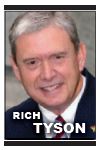By Richard Tyson
The word “routine,” used as a noun, is defined as “a sequence of actions regularly followed, a fixed program.” As a verb, it is the act of organizing a function or process according to specific activities consistently followed, as in “the system had been routined to assure uniform high-quality results.” As an adjective, it communicates an unswerving schedule of activities, e.g., “employees routinely take these actions every week.”
Virtually all people have routines in their lives. These may be as simple as getting out of bed at the same time every morning, or brushing our teeth. At work, we may routinely start the day with a cup of coffee before routinely settling in on the Internet with email or a news service. We may routinely crank up the machine that will crank out the widgets we will produce today.
Routine activities are an essential part of work — and our lives. They tend to eliminate the need for making the same decision multiple times, and substantially reduce ambiguity as to the “right course of action.” They define a path for each day, week or month, whereby our performance will be acceptable to ourselves and others who rely on that performance.
Routine work activities often predictably lead to desired outcomes, including operational objectives, customer satisfaction and financial success. Indeed, when any commercial venture is launched, it is critically important that routine processes and systems are clearly defined with an eye to cause and effect; that is, that routine activities do, in fact, render operational excellence.
When partners, associates or worker bees are brought into our ventures, it is essential that we set forth the routines we expect to be followed in the day-to-day operation of the business. Newcomers need to be assimilated into the operating routines inherent in their roles as quickly as possible. This is the essence of onboarding.
A close associate of ours at CEObuilder, Dr. S. Brett Savage, refers to this as introducing a new employee to Phase 1 of his or her career. The goal is to bring her or him to the status of “individual contributor,” or Phase 2, as quickly as possible, wherein they become outstanding in their contribution within the business. Routine, in this regard, is highly desirable. It addresses the need for effectiveness (delivering consistent desired outcomes) and efficiency (continually improving the rate throughput is achieved).
Often, we get so good at our routines that they become second nature to us; they become habits. While habits can be beneficial, they can also lead to “purpose amnesia,” i.e., we forget why we do what we do.
The story is told of a newlywed husband who noticed that every time his wife cooked a pot roast, she would routinely cut off and throw away an inch of the meat on each end of the roast. Being waste-conscious, he asked his wife why she did this. Her answer was, “Because that’s how you’re supposed to cook pot roast.”
Dissatisfied with her answer, he pressed the issue. She finally admitted that she had learned this routine from her mother, who always created culinary masterpieces. That sufficed for the time being. However, when his mother-in-law came for a visit, he asked her why she cut off the ends of the roast. Her answer: “That’s how you’re supposed to do it.”
This answer wasn’t any more satisfying than the first time he heard it, so the young man pressed her further. She finally admitted that she had learned this routine from her mother.
Now, more intrigued than ever, he sought the opportunity to question his wife’s grandmother. He asked, “Your daughter told me you taught her to cut an inch off each end of a pot roast before cooking it. She swore it was a requirement, but I’m dying to know why. Is there any sane reason to throw away two inches of perfectly good meat in order to cook a pot roast?”
Laughing, Grandma said, “Heavens, no! Back then we were very poor and I only had one pan for cooking pot roast. It was so small, I had to cut the ends off of the roast to get it to fit in the pan!”
Make no mistake, routine processes are essential in any business. However, we must take care to periodically step back and ask, “Why do we do it this way?” By so doing, our Phase 2 employees will substantially increase their individual contributions and help us avoid the insidious demon of purpose amnesia.
Richard Tyson is the founder, principal owner and president of CEObuilder, which provides forums for consulting and coaching to executives in small businesses.








